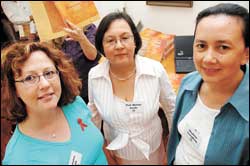HIV/AIDS hampers child rights
05 December 2005
Children's rights: (From left) Communication manager Charmaine Smith, director Professor Marian Jacobs and deputy director Dr Maylene Shung-King at the launch of the Children's Institute's Child Gauge 2005, which they co-edited.
South Africa needs a comprehensive response to children infected and affected by HIV/AIDS, one of the main impediments to the realisation of children's rights.
This was the message from UCT's Children's Institute (CI), at the launch of a new publication, the South African Child Gauge 2005, on World AIDS Day on December 1.
The new publication is aimed at providing an annual reminder of the challenges that South Africa still faces in promoting and protecting child rights. This year's issue focused on HIV/AIDS. Every year, the gauge will present an analysis of legislative and policy developments related to children's rights, qualitative essays on a themed topic, and child-centred data on the realisation of children's socio-economic rights.
At the launch, Children's Institute director Professor Marian Jacobs cited Medical Research Council (MRC) research indicating that 40% of deaths of children under the age of five years are directly attributable to HIV/AIDS.
This means that HIV/AIDS is the leading cause of deaths among children under-five years of age - nationally and across all provinces - primarily due to HIV transmission before and during the birth process. At the same time, diseases of poverty account for at least 30% of all under-five child deaths.
According to the gauge, the second major obstacle to the realisation of child rights is the ongoing income inequality and widespread poverty in the country. Recent figures show that almost 12-million children (66% of the child population) are living in poverty.
Jacobs said the fact that the unemployment rate was rising alongside the HIV infection rate was of great concern because poverty deepens the effects of HIV/AIDS on households, while the disease in turn aggravates existing poverty.
"Given that HIV/AIDS is compounding the general ill-health effects of poverty, it is important to reflect on the comprehensive health care needs of children with HIV infection. A comprehensive health care package can improve child health, prolong life and delay the need for antiretrovirals."
The institute's deputy director, Dr Maylene Shung-King, who co-authored a discussion paper on where children fit in the government's plan for the care, management and treatment of HIV/AIDS, said the first priority - and the most significant response - was the prevention of childhood HIV infection.
"Around the world, almost two-thirds of new infections that occur in children are through mother-to-child transmission. It therefore makes sense to target mother-to-child transmission as the first area of prevention. In this regard there is an urgent need for a focused drive to help pregnant women counter the fear of stigma to encourage voluntary counselling and testing, and to emphasise the benefits of prevention of mother-to-child transmission to the next generation, while improvements to health service delivery should also be prioritised."
The institute's analysis of the government's plan on the care, management and treatment of HIV/AIDS indicated that it did not adequately address two key interventions - reducing HIV infection in adults and the prevention of mother-to-child transmission. Both these interventions would have the greatest effect on reducing HIV in children.
Other issues related to children and HIV/AIDS highlighted in the text were the need for appropriate social security to children affected by HIV/AIDS; the use of schools as nodes of care and support to identify and support children most in need; and the importance of children's participation in decisions that affect their lives, particularly in the context of poverty and HIV/AIDS.
The South African Child Gauge can be dowloaded at: http://web.uct.ac.za/depts/ci/.
 This work is licensed under a Creative Commons Attribution-NoDerivatives 4.0 International License.
This work is licensed under a Creative Commons Attribution-NoDerivatives 4.0 International License.
Please view the republishing articles page for more information.










